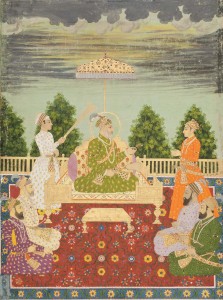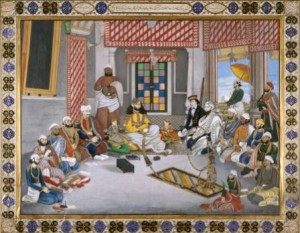Home / Press
Press
Contact: Elaine Merguerian 212.327.9271, [email protected]
ASIA SOCIETY MUSEUM PRESENTS FIRST-EVER MAJOR EXHIBITION
EXPLORING ARTWORK FROM INDIA’S LATE MUGHAL PERIOD
PRINCES AND PAINTERS IN MUGHAL DELHI, 1707–1857
On view February 7 through May 6, 2012

Bahadur Shah I with his sons handing a sarpech to a grandson, ca. 1710. Opaque watercolor and gold on paper. H. 12 3⁄8 × W. 9 1⁄4 in. (31.4 × 23.5 cm). The San Diego Museum of Art, Edwin Binney 3rd Collection, 1990.368.
Princes and Painters in Mughal Delhi, 1707–1857 brings together 100 masterpieces created during an artistically rich period in India’s history. This major international loan exhibition provides a new look at an era of significant change during which the Mughal capital in Delhi shifted from being the heart of the late Mughal Empire to becoming the jewel in the crown of the British Raj.
The exhibition includes jewel-like portrait paintings, striking panoramas, and exquisite decorative arts crafted for Mughal emperors and European residents alike, as well as historical photographs.
The exhibition is curated by William Dalrymple and Yuthika Sharma. It is accompanied by a 264-page illustrated book with essays by William Dalrymple, Yuthika Sharma, Jean Marie Lafont, Malini Roy, Sunil Sharma, and J.P. Losty, published by Asia Society Museum in association with Yale University Press, New Haven and London.
“Princes and Painters in Mughal Delhi, 1707–1857 is a reappraisal of a transitional era in India that provided unprecedented impetus for artistic innovation and experimentation,” says Melissa Chiu, Asia Society Museum Director and Vice President for Global Art Programs. “We’re pleased to be taking a new approach to this magnificent and vibrant work with notable author William Dalrymple and art historian Yuthika Sharma as curators.”
The exhibition focuses on the reigns of the last four Mughal emperors: Muhammad Shah (reigned 1719–1748), Shah Alam II (reigned 1759–1806), Akbar Shah II (reigned 1806–1837) and Bahadur Shah II Zafar (reigned 1837–1857).

Ghulam Ali Khan (active 1817–55) Nawab Muhammad Abd al-Rahman Khan of Jhajjar with his court and an East India Company political officer in the cool weather, 1852. Watercolor, body color, and gold H. 12 3⁄4 × W. 16 15⁄16 in. (32.4 × 43 cm). British Library, Add.Or.4681
Having lost military, political and economic power to the newlyarrived British in Calcutta, Delhi continued to maintain its extraordinary cultural, literary, and artistic patronage networks. Artists were supported by the Mughal court in Delhi and the city’s ascendant European residents, creating an environment of extraordinary interaction and influence between them and the new world of the British East India Company.
As the British took over the reign of a dispersed empire from the Mughals in 1803, they were enamored of its courtly elegance and sought to participate in its culture as patrons and enthusiasts. Company painting, involving artistic commissions undertaken by Indian artists for officers of the British East India Company, was practiced alongside Mughal court painting, with both patrons utilizing the services of a common group of artists.
The exhibition looks at recognized works by Delhi-based court artists Nidha Mal and Chitarman, and less familiar works by artists such as Ghulam Murtaza Khan, Ghulam Ali Khan, and Mazhar Ali Khan. In addition to Mughal miniatures produced under later emperors, this exhibition highlights a selection of so-called Company School paintings produced for Delhi-based personalities such as William Fraser, James Skinner, and Thomas Metcalfe. The exhibition also chronicles the rise in genre portraiture during this era, epitomized by character studies of urban and rural residents of Delhi.
Related programs
Exhibition-related programs include a lecture with co-curator William Dalrymple on the artistic and political complexities of art created for the Indian court and European patrons in Delhi, on Thursday, February 23, at 6:00 P.M. (free for Asia Society Members; tickets available that evening to members of the public on a first-come, first-served basis); and an evening of celebrating the era of India’s last Mughals featuring a reading by William Dalrymple and a performance by North Indian vocalist Vidya Shah, on Sunday, February 26, at 7:00 P.M. In addition, AsiaStore will feature a series of artisan demonstrations including: block printing by Mahesh Jain, Thurs – Fri, February 9 – 10, from 12:30 P.M. to 4:00 P.M.; Zardozi embroidery by Shyam Prasad, Thurs – Fri, February 16 – 17, from 12:30 p.m. to 4:00 p.m.; and Kunday Jewelry by Asif Khan, Thurs – Fri, Feb 23 – 24, from 12:30 P.M. to 4:00 P.M.
Exhibition funding
The exhibition is made possible by the generous support of The Partridge Foundation, a John and Polly Guth Charitable Fund.
Asia Society acknowledges other generous underwriters, including the E. Rhodes and Leona B. Carpenter Foundation, Lisina M. Hoch, the National Endowment for the Arts, and the Blanchette Hooker Rockefeller Fund.
Additional support is provided by Sonny and Michelle Kalsi, Princess Shamina Talyarkhan, Marie-Hélène Weill, Sonny and Gita Mehta, Victor and Tara Menezes, Saroj and Sreedhar Menon, Rohit and Katherine Desai, Amna and Ali Naqvi, and an Anonymous Donor.
About Asia Society Museum
Asia Society Museum presents groundbreaking exhibitions and artworks, many previously unseen in North America. The Museum is known for its permanent collection of masterpiece-quality works gifted to the Society by Mr. and Mrs. John D. Rockefeller 3rd. Through its exhibitions and related public programs, Asia Society provides a forum for the issues and viewpoints reflected in both traditional and contemporary Asian art. Founded in 1956, Asia Society is a nonprofit educational institution with offices in Hong Kong, Houston, Los Angeles, Manila, Melbourne, Mumbai, New York, San Francisco, Seoul, Shanghai and Washington, D.C.
Asia Society Museum is located at 725 Park Avenue (at 70th Street), New York City. The Museum is open Tuesday through Sunday from 11:00 A.M. – 6:00 P.M. and Friday from 11:00 A.M. – 9:00 P.M. Closed on Mondays and major holidays. General admission is $10, seniors $7, students $5, and admission is free for members and persons under 16. Free admission Friday evenings, 6:00 P.M. – 9:00 P.M. The Museum is closed Fridays after 6:00 P.M. from July 1 through Labor Day. AsiaSociety.org/museum.

